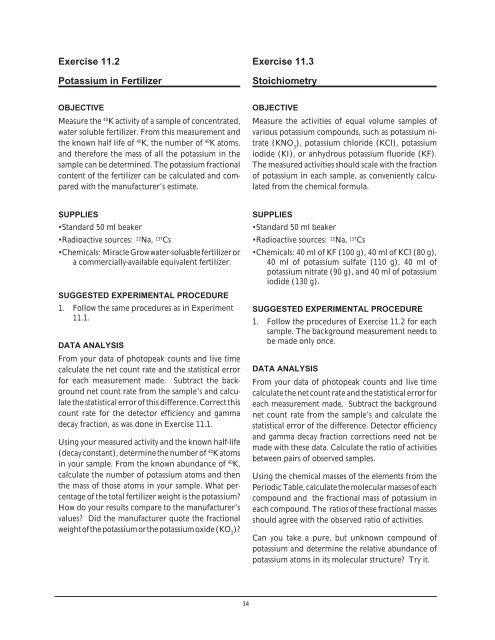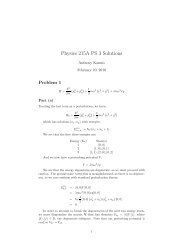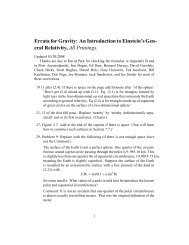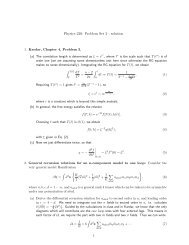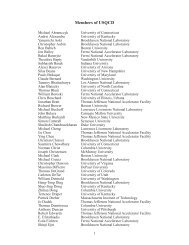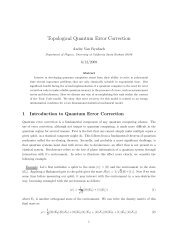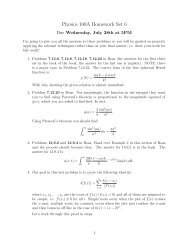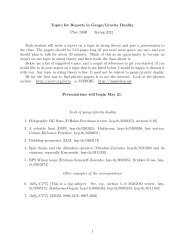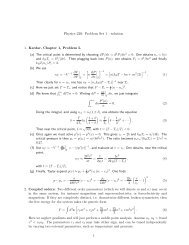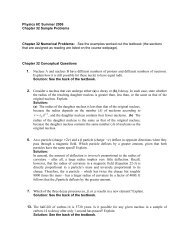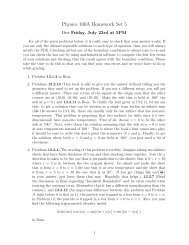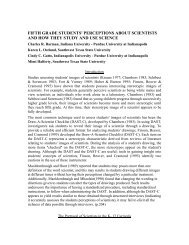Nuclear Spectroscopy
Nuclear Spectroscopy
Nuclear Spectroscopy
You also want an ePaper? Increase the reach of your titles
YUMPU automatically turns print PDFs into web optimized ePapers that Google loves.
Exercise 11.2<br />
Potassium in Fertilizer<br />
Exercise 11.3<br />
Stoichiometry<br />
OBJECTIVE<br />
Measure the 40 K activity of a sample of concentrated,<br />
water soluble fertilizer. From this measurement and<br />
the known half life of 40 K, the number of 40 K atoms,<br />
and therefore the mass of all the potassium in the<br />
sample can be determined. The potassium fractional<br />
content of the fertilizer can be calculated and compared<br />
with the manufacturer’s estimate.<br />
OBJECTIVE<br />
Measure the activities of equal volume samples of<br />
various potassium compounds, such as potassium nitrate<br />
(KNO 3<br />
), potassium chloride (KCl), potassium<br />
iodide (KI), or anhydrous potassium fluoride (KF).<br />
The measured activities should scale with the fraction<br />
of potassium in each sample, as conveniently calculated<br />
from the chemical formula.<br />
SUPPLIES<br />
•Standard 50 ml beaker<br />
•Radioactive sources: 22 Na, 137 Cs<br />
•Chemicals: Miracle Grow water-soluable fertilizer or<br />
a commercially-available equivalent fertilizer.<br />
SUGGESTED EXPERIMENTAL PROCEDURE<br />
1. Follow the same procedures as in Experiment<br />
11.1.<br />
DATA ANALYSIS<br />
From your data of photopeak counts and live time<br />
calculate the net count rate and the statistical error<br />
for each measurement made. Subtract the background<br />
net count rate from the sample’s and calculate<br />
the statistical error of this difference. Correct this<br />
count rate for the detector efficiency and gamma<br />
decay fraction, as was done in Exercise 11.1.<br />
Using your measured activity and the known half-life<br />
(decay constant), determine the number of 40 K atoms<br />
in your sample. From the known abundance of 40 K,<br />
calculate the number of potassium atoms and then<br />
the mass of those atoms in your sample. What percentage<br />
of the total fertilizer weight is the potassium?<br />
How do your results compare to the manufacturer’s<br />
values? Did the manufacturer quote the fractional<br />
weight of the potassium or the potassium oxide (KO 2<br />
)?<br />
SUPPLIES<br />
•Standard 50 ml beaker<br />
•Radioactive sources: 22 Na, 137 Cs<br />
•Chemicals: 40 ml of KF (100 g), 40 ml of KCl (80 g),<br />
40 ml of potassium sulfate (110 g), 40 ml of<br />
potassium nitrate (90 g), and 40 ml of potassium<br />
iodide (130 g).<br />
SUGGESTED EXPERIMENTAL PROCEDURE<br />
1. Follow the procedures of Exercise 11.2 for each<br />
sample. The background measurement needs to<br />
be made only once.<br />
DATA ANALYSIS<br />
From your data of photopeak counts and live time<br />
calculate the net count rate and the statistical error for<br />
each measurement made. Subtract the background<br />
net count rate from the sample’s and calculate the<br />
statistical error of the difference. Detector efficiency<br />
and gamma decay fraction corrections need not be<br />
made with these data. Calculate the ratio of activities<br />
between pairs of observed samples.<br />
Using the chemical masses of the elements from the<br />
Periodic Table, calculate the molecular masses of each<br />
compound and the fractional mass of potassium in<br />
each compound. The ratios of these fractional masses<br />
should agree with the observed ratio of activities.<br />
Can you take a pure, but unknown compound of<br />
potassium and determine the relative abundance of<br />
potassium atoms in its molecular structure? Try it.<br />
34


